It’s not only humans and other living objects that have anatomy, a machine, bicycle for example, also has anatomy. Bike anatomy often differs from one type to another. By means, a road bike anatomy will be different from a mountain bike anatomy and cruiser bike anatomy.
For a bike enthusiast, understanding the anatomy of a bike will not only help them differentiate one bike from another but will also be helpful in case one day, they are going to make an upgrade to their bike. So today, we are going to break down the anatomy of a road bike. If you are interested, you can read this article thoroughly and take notes of it. Happy reading!
What is a Road Bike?
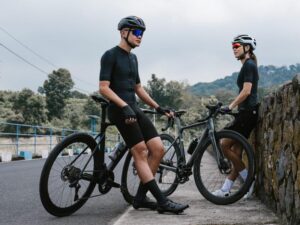
The term road bike is used to describe a type of bike that is built for traveling speed and primarily ridden on a smooth surface such as a paved road. Initially, there are few types of road bikes, such as:
- Performance (Race) Road Bike: mostly used by cyclists who want a fast bike that can corner neatly and get them to the front of the race with good endurance. A performance road bike is also good for climbing;
- All-rounder Road Bike: a perfect choice for cyclists who are looking for a bike that is light enough for climbing and aerodynamic enough for sprinting yet offers comfort like an endurance bike;
- Gravel Road Bike: this type of bike is adapting a tour bike geometry with a setup of an endurance bike alike. Because the gravel bike is built with a lightweight frame with large tire clearance and easy handling, it’s also known as an all-road bike, suitable for riders who seek a bike that can go fast on single trail tracks that is also suitable for commuters.
Road Bike Anatomy
Cycling is a fun activity and has been back to its peak of popularity ever since the pandemic. However, buying a bicycle and its parts can often cause people to feel perplexed since the term used by the shopkeeper seemingly comes from another language that newbies can’t catch up with. At some points, it gives you no different vibe than buying a personal computer.
Addressing this issue, we feel like it is important for a cyclist—especially a newbie—to learn about bicycle anatomy and familiarize yourself with the terms often used to address each part of the bike, and today, we are going to start with the road bike.
Generally, the road bike anatomy—or known as road bike parts consist of:
- Bike frame parts include the top tube, head tube, down tube, seat tube, seat stays, and chain stays;
- The front side of the bike: is made up of the fork, headset, stem, and handlebars;
- Bike wheel parts that come with the hub, rim, spokes, tire, and valve
- Groupset such as crankset/chainset, bottom bracket, chain, front derailleur, cassette, rear derailleur, brake levers, and brake.
- Other bike parts like the pedals, saddle, and seat post.
Road Bike Anatomy Description
We understand that only asking you to remember each name of the part is not going to help you communicate well with the folks that work in the bike shop therefore, we prepared a brief explanation of each important part of the bike, here you go:
Bike Frame and Fork
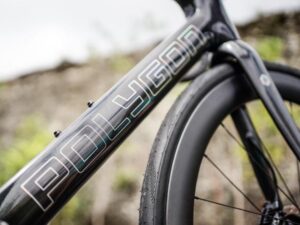
It’s fair to say that a frame is the heart of a bike. The first rule in choosing a road bike frame is lightweight and aerodynamic at the same time, they should be strong and rigid.
Generally, there are few variations of a bike frame such as;
- Diamond Frame: consists of a head tube, top tube, down tube, and seat tube that is joined by a pair of seat stays and chain stays;
- Step-through Frame: with a top tube that connects the middle of the seat tube instead of the top and resulting in a lower standover height;
- Folding Frame: designed with a hinge that allows riders to fold the bike into a more compact form. The hinge on the folding bike frame is one of the parts that differ the folding bike anatomy from other types of bikes.
A road bike frame usually comes in diamond-shaped ones, with parts of:
Head Tube
A short tube at the front of the frame that connects the handlebars to the wheel fork as well as the down tube and top tube is known as the head tube. This part contains the headset that allows riders to steer the front wheel by handlebars.
Top Tube
Also known as the cross-bar and is the part where bikers step over to mount the bike. In most cases, it runs parallel to the ground but might be slightly angled.
Down Tube
This tube is a long tube that runs from the head tube down to the lower end of the seat tube and is usually the thickest part of a bike frame. The rider can usually see the bike’s logo being printed here and if one is the type who carries a water bottle during the ride, the cage for the water bottle is installed on this part.
Seat Tube
This part runs from the saddle down to the pedal area and is the part that connects the top tube with the down tube, seat stays, and chain stays. If riders want to adjust their saddle height, they can do that by increasing or decreasing how deep the seat post descends into the seat tube.
Seat Stays
The two thinner tubes run from underneath the saddle to the rear wheel hub and each seat stays at a rear drop-out that is connected to one side of the axle in the rear wheel.
Chain stays
Another two thinner tubes but unlike seat stays, a chain stays run parallel to the ground from either side of the rear wheel and runs alongside the bike chain.
Fork
A part that connects the front wheel to the frame and handles parts. The fork blades extend downwards from the head tube, one on each side of the wheel. There’s also a steerer tube that connects to the headset hidden inside the head tube.
Bike frames usually come made of carbon fiber, aluminum alloy, or mixed carbon and alloy. The steel-made road bike frame is uncommon since the steel material didn’t deliver the lightweight needed by the road bike.
Handle Part
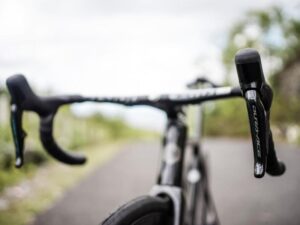
As the name suggests, this is a bike part located at the front of the bike, like:
Headset
A set of components that sits inside the head tube, connecting the frame to the wheel fork and handle parts. There are bearings in the headset which allow it to rotate causing a turn of the handlebars processing the turn of the front wheel.
Stem
The part that connects a steerer tube of the fork to the handlebars and it sticks out forwards from the top of a head tube. The handlebars run through the end of the stem.
Handlebars
Initially, a road bike will use the drop bar handlebar. It is a part that connects to the bike through the stem.
Bike Wheel

A bike wheel usually consists:
Hub
The center of the bike wheel and made of three parts: the hub shell, the bearings, and the axle. The Hub shell is the exterior part that attaches the spokes to attach on. Bearings sit between the axle and the shell allowing the wheel to spin freely around the axle.
Rim
Just like the frame, the rim’s manufacturing in the early days used steel materials until the 1980s, the frame is usually made of steel. If the bike is using a rim brake as its braking system, the rim should come with a smooth surface on the side for the brake pads to grip on.
Spokes
This part connects the rim to the hub, applying tension evenly to all directions, creating a strong and stable wheel that can support the rider’s weight along with the force riders apply when pedaling.
Tire
Mounted onto the wheel rim, is a part that connects riders to the ground. Bike tires come in three types: tubeless tires, clincher tires, and tubular tires. You can refer to our other blog about how to choose road bike tires for a more comfortable ride in case you need more detailed information about this.
Valve
There are two commonly used types of valve: Schrader and Presta. The Presta valve is exclusively used in a bicycle while the Schrader valve is also used for cars and motorbikes.
Groupset

Also known as the part that keeps the bike machine working, such as:
Crankset/Chainset
The part of the bike consists of the chainrings and the crank arms where the pedal is being attached. The chainrings are also addressed as the front gears on a bike, on a single bike there’s only one chainring and the geared bike can have a chainring up to three. A crankset is attached to the frame by the bottom bracket to the rear wheel, and, from the chain to the riders by pedals.
Bottom Bracket
Part of the bike consists of a spindle and bearings and is part where the crank arms rotate around.
Brake Levers and Shifter
If the frame is the heart of a bike, then brake levers are the heartbeat of a bike. This part allows riders to slow down the bike or even put the bike to a full stop with just a squeeze or pull.
If we talk about brake levers, of course, we can’t skip the shifter. The shifter is also known as gear control/gear lever, the component of a bike that is used to control the gearing mechanism and select the desired ratio. Usually, this part controls a derailleur mechanism or an internal hub mechanism by moving a cable that connects the shifter to the gear mechanism.
Brake
The common types that are widely used by the manufacturer are rim brakes and disc brakes. In the old days, the road bike was built with rim brakes only, until recent days, most road bikes are equipped with disc brakes by their manufacturer.
Chain
The part that transfers the power of the rider’s legs to the rear wheel, loops around the chainring in the crankset along the length of the chain stays and around the sprockets of the cassette in the rear wheel.
Front Derailleur
Only present on bikes with more than one front gear or chainrings because the front derailleur is the part that helps riders to move the chain from one chainring to another as riders shift the gears.
Cassette
Stack of different sized sprockets that are attached to the hub of the rear wheel, there will be more than one sprocket to make a sprocket set, for example, 10 sprockets for a 10-speed cassette, 11 sprockets for 11-speed, and 12 sprockets to make 12-speed.
Rear Derailleur
Same as the front derailleur which is only present on a bike for more than one gear as the rear derailleur is a bike part that moves the chain from one cassette sprocket to another on the rear wheel when riders shift the gear.
Other Bike Parts
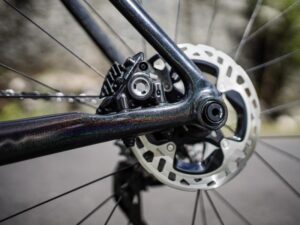
The essential parts that mostly affect the rider’s comfort during the ride, like pedals that come in three types: clipless, flat, and three-bolt clipless pedals. The saddle as the part where riders spend most of the time sitting on it also comes with lots of different materials, and seat posts to let riders adjust the saddle and have a better position for riding the bike.
Conclusion
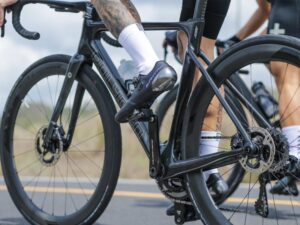
Most Polygon road bikes in performance type are made of a carbon fiber frame and the all-rounder type is built with mixed carbon-alloy materials. For groupsets, the most common use is from Shimano, SRAM, and Tektro. Polygon road bike using the Shimano groupset the most.
Looking for a bike with high-quality parts and offers a competitive price? You should take a look at the Polygon bike. You can visit Rodalink, the official distributor of Polygon, and many other renowned brands. With a wide range of bikes selection, you are guaranteed to find the bike suitable for your riding style and budget.
Besides, you no longer need to worry about being unable to correctly assemble your bike because, for every purchase at Rodalink, they will deliver your bike to your doorstep in a ready-to-ride form. Visit Rodalink right now and have hassle-free shopping for your cycling needs!
